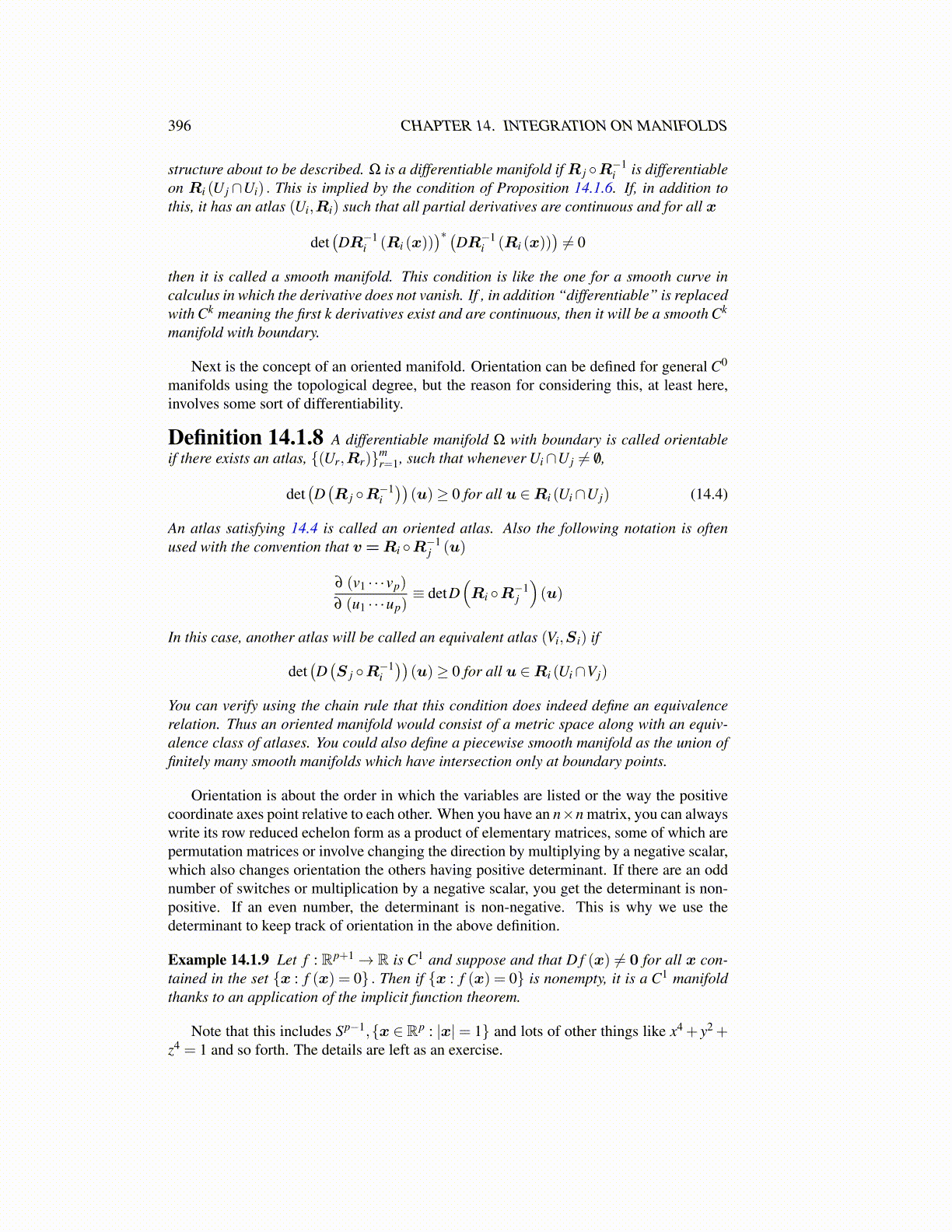
396 CHAPTER 14. INTEGRATION ON MANIFOLDS
structure about to be described. Ω is a differentiable manifold ifR j ◦R−1i is differentiable
on Ri (U j ∩Ui) . This is implied by the condition of Proposition 14.1.6. If, in addition tothis, it has an atlas (Ui,Ri) such that all partial derivatives are continuous and for all x
det(DR−1
i (Ri (x)))∗ (
DR−1i (Ri (x))
)̸= 0
then it is called a smooth manifold. This condition is like the one for a smooth curve incalculus in which the derivative does not vanish. If , in addition “differentiable” is replacedwith Ck meaning the first k derivatives exist and are continuous, then it will be a smooth Ck
manifold with boundary.
Next is the concept of an oriented manifold. Orientation can be defined for general C0
manifolds using the topological degree, but the reason for considering this, at least here,involves some sort of differentiability.
Definition 14.1.8 A differentiable manifold Ω with boundary is called orientableif there exists an atlas, {(Ur,Rr)}m
r=1, such that whenever Ui∩U j ̸= /0,
det(D(R j ◦R−1
i))
(u)≥ 0 for all u ∈Ri (Ui∩U j) (14.4)
An atlas satisfying 14.4 is called an oriented atlas. Also the following notation is oftenused with the convention that v=Ri ◦R−1
j (u)
∂ (v1 · · ·vp)
∂ (u1 · · ·up)≡ detD
(Ri ◦R−1
j
)(u)
In this case, another atlas will be called an equivalent atlas (Vi,Si) if
det(D(S j ◦R−1
i))
(u)≥ 0 for all u ∈Ri (Ui∩Vj)
You can verify using the chain rule that this condition does indeed define an equivalencerelation. Thus an oriented manifold would consist of a metric space along with an equiv-alence class of atlases. You could also define a piecewise smooth manifold as the union offinitely many smooth manifolds which have intersection only at boundary points.
Orientation is about the order in which the variables are listed or the way the positivecoordinate axes point relative to each other. When you have an n×n matrix, you can alwayswrite its row reduced echelon form as a product of elementary matrices, some of which arepermutation matrices or involve changing the direction by multiplying by a negative scalar,which also changes orientation the others having positive determinant. If there are an oddnumber of switches or multiplication by a negative scalar, you get the determinant is non-positive. If an even number, the determinant is non-negative. This is why we use thedeterminant to keep track of orientation in the above definition.
Example 14.1.9 Let f : Rp+1→ R is C1 and suppose and that D f (x) ̸= 0 for all x con-tained in the set {x : f (x) = 0} . Then if {x : f (x) = 0} is nonempty, it is a C1 manifoldthanks to an application of the implicit function theorem.
Note that this includes Sp−1,{x ∈ Rp : |x|= 1} and lots of other things like x4 + y2 +z4 = 1 and so forth. The details are left as an exercise.